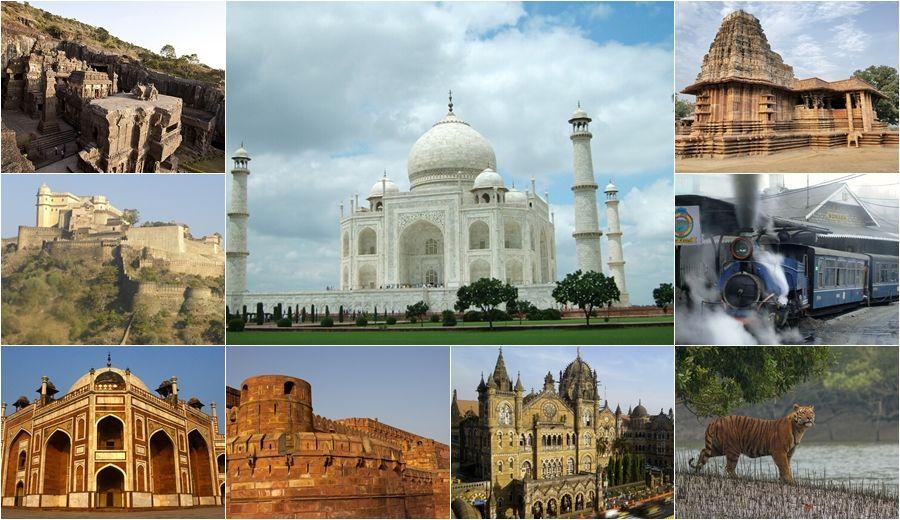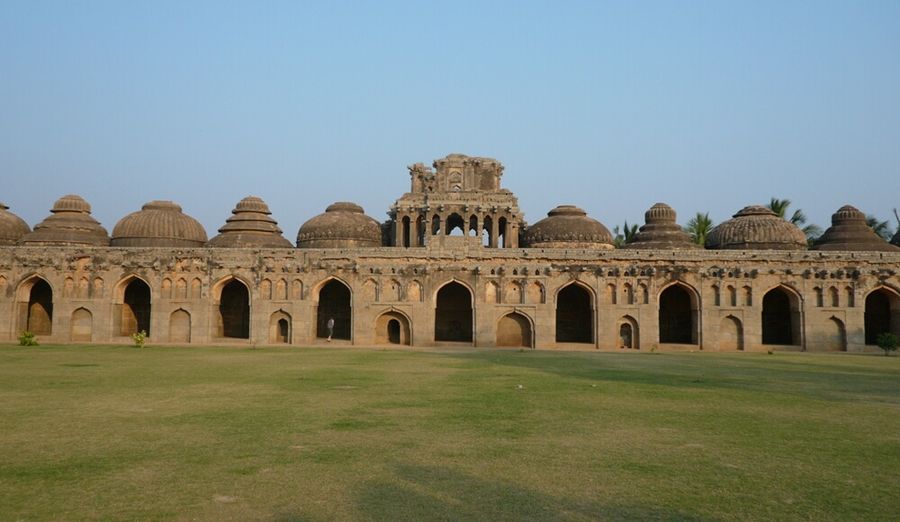
- India has 40 UNESCO World Heritage Sites.
- India is the 6th country in the world to have the most UNESCO Heritage Sites.
India is a country of rich cultural and natural heritage. Right from the Himalayas to the southern tip of the country, there are hundreds of natural and man-made places and monuments that signify the different cultures, rituals, and beliefs that have been part of India for centuries. This is also why it’s not surprising that India is the sixth country in the world to have the most number of UNESCO (United Nations Educational, Scientific and Cultural Organisation) World Heritage Sites.
1. Agra Fort

Located near the gardens of the Taj Mahal, the Agra Fort is an important 16th-century Mughal monument that is made of red sandstone. Within its 2.5-km-long enclosure walls, the fortress encompasses what was once the imperial city of the Mughal rulers.
2. Ajanta Caves

(Source: UNESCO Website)
The Ajanta Caves were the first Buddhist cave monuments that date from the 2nd and 1st centuries B.C. to around 5th and 6th centuries A.D. Located in the Aurangabad district of Maharashtra state in India, the paintings and sculptures of Ajanta are considered masterpieces of Buddhist religious art.
3. Archaeological Site of Nalanda Mahavihara

(Source: UNESCO Website)
The Nalanda Mahavihara site, located in the State of Bihar, comprises the archaeological remains of a monastic and scholastic institution dating from the 3rd century BCE to the 13th century CE. Nalanda stands out as the most ancient university in the Indian Subcontinent.
4. Buddhist Monuments at Sanchi

(Source: UNESCO Website)
Located in Bhopal, the site of Sanchi comprises a group of Buddhist monuments (monolithic pillars, palaces, temples and monasteries) all in different states of conservation most of which date back to the 2nd and 1st centuries B.C. It is the oldest Buddhist sanctuary in existence and was a major Buddhist centre in India until the 12th century A.D.
5. Champaner-Pavagadh Archaeological Park

(Source: UNESCO Website)
The Champaner-Pavagadh Archaeological Park is a concentration of largely unexcavated archaeological, historic and living cultural heritage properties situated in an impressive landscape which includes prehistoric (chalcolithic) sites. The site also includes, among other vestiges, fortifications, palaces, religious buildings, residential precincts, agricultural structures and water installations, from the 8th to 14th centuries.
6. Chhatrapati Shivaji Terminus (CST)
)
(Source: UNESCO Website)
The Chhatrapati Shivaji Terminus (CST), formerly known as Victoria Terminus (VT) Station, is the epicentre of Mumbai’s local train system, which is also called the city’s lifeline. The building is an outstanding example of Victorian Gothic Revival architecture in India, blended with themes deriving from Indian traditional architecture.
7. Churches and Convents of Goa

(Source: UNESCO Website)
The churches and convents of Goa – particularly the Church of Bom Jesus, which contains the tomb of St Francis-Xavier – illustrate the evangelization of Asia. These monuments were influential in spreading forms of Manueline, Mannerist and Baroque art in all the countries of Asia where missions were established.
8. Dholavira: A Harappan City

(Source: UNESCO Website)
The ancient city of Dholavira, the southern centre of the Harappan Civilization, is sited on the arid island of Khadir in the State of Gujarat. Occupied between ca. 3000-1500 BCE, the archaeological site, one of the best-preserved urban settlements from the period in Southeast Asia, comprises a fortified city and a cemetery.
9. Elephanta Caves

(Source: UNESCO Website)
The ‘City of Caves’, on an island in the Sea of Oman close to Bombay, contains a collection of rock art linked to the followers of Shiva. Here, Indian art has found one of its most perfect expressions, particularly the huge high reliefs in the main cave.
10. Ellora Caves

(Source: UNESCO Website)
Located near Aurangabad, Maharashtra, the Ellora Caves are 34 monasteries and temples, extending over more than 2 km, which were dug side by side in the wall of a high basalt cliff. The sequence of monuments, which date from A.D. 600 to 1000, depict the civilization of ancient India.
11. Fatehpur Sikri

(Source: UNESCO Website)
Built during the second half of the 16th century by the Emperor Akbar, Fatehpur Sikri, which means the City of Victory, was the capital of the Mughal Empire for only some 10 years. Located in Uttar Pradesh, India, Fatehpur Sikri is a complex of monuments and temples that includes one of the largest mosques in India, the Jama Masjid (Mosque).
12. Great Living Chola Temples

(Source: UNESCO Website)
Built by kings of the Chola Empire, the Great Living Chola Temples have stretched over all of south India and the neighbouring islands. The site includes three great 11th- and 12th-century Temples: The Brihadisvara Temple at Thanjavur, the Brihadisvara Temple at Gangaikondacholisvaram and the Airavatesvara Temple at Darasuram.
13. Group of Monuments at Hampi

(Source: UNESCO Website)
Hampi was the last capital of the last great Hindu Kingdom of Vijayanagar. Its fabulously rich princes built Dravidian temples and palaces which won the admiration of travellers between the 14th and 16th centuries. Conquered by the Deccan Muslim confederacy in 1565, the city was pillaged for over six months before being abandoned.
14. Group of Monuments at Mahabalipuram

(Source: UNESCO Website)
This group of sanctuaries, founded by the Pallava kings, was carved out of rock along the Coromandel coast in the 7th and 8th centuries. It is known especially for its rathas (temples in the form of chariots), mandapas (cave sanctuaries), giant open-air reliefs such as the famous ‘Descent of the Ganges’, and the temple of Rivage, with thousands of sculptures to the glory of Shiva.
15. Group of Monuments at Pattadakal

(Source: UNESCO Website)
Pattadakal, in Karnataka, represents eclectic art, which is a blend of architectural forms from northern and southern India, created in the 7th and 8th centuries under the Chalukya dynasty. One masterpiece from the group stands out – the Temple of Virupaksha, built c. 740 by Queen Lokamahadevi to commemorate her husband’s victory over the kings from the South.
16. Hill Forts of Rajasthan

(Source: UNESCO Website)
The serial site, situated in the state of Rajasthan, includes six majestic forts in Chittorgarh; Kumbhalgarh; Sawai Madhopur; Jhalawar; Jaipur, and Jaisalmer. The eclectic architecture of the forts, some up to 20 kilometres in circumference, bears testimony to the power of the Rajput princely states that flourished in the region from the 8th to the 18th centuries.
17. Historic City of Ahmadabad

(Source: UNESCO Website)
The old city of Ahmadabad, founded by Sultan Ahmad Shah in the 15th century, on the eastern bank of the Sabarmati river, presents a rich architectural heritage from the sultanate period, notably the Bhadra citadel, the walls and gates of the Fort city and numerous mosques and tombs as well as important Hindu and Jain temples of later periods.
18. Humayun’s Tomb, Delhi

(Source: UNESCO Website)
This tomb, built in 1570, is of particular cultural significance as it was the first garden tomb on the Indian subcontinent. It inspired several major architectural innovations, culminating in the construction of the Taj Mahal.
19. Jaipur City, Rajasthan

(Source: UNESCO Website)
Yes, the entire city of Jaipur is a UNESCO world heritage site. Founded in 1727 by Sawai Jai Singh II, unlike other cities in the region located in hilly terrain, Jaipur was established on the plain and built according to a grid plan interpreted in the light of Vedic architecture. The city’s urban planning shows an exchange of ideas from ancient Hindu and early modern Mughal as well as Western cultures.
20. Kakatiya Rudreshwara Temple, Telangana
%20Temple,%20Telangana)
(Source: UNESCO Website)
Rudreshwara, popularly known as Ramappa Temple, is located in the village of Palampet approximately 200 km northeast of Hyderabad, in the State of Telangana. It is the main Shiva temple in a walled complex built during the Kakatiyan period (1123–1323 CE) under rulers Rudradeva and Recharla Rudra.
21. Khajuraho Group of Monuments

(Source: UNESCO Website)
Located in Madhya Pradesh, the temples at Khajuraho were built during the Chandella dynasty, which reached its apogee between 950 and 1050. Only about 20 temples remain; they fall into three distinct groups and belong to two different religions – Hinduism and Jainism.
22. Mahabodhi Temple Complex at Bodh Gaya

(Source: UNESCO Website)
The Mahabodhi Temple Complex is one of the four holy sites related to the life of the Lord Buddha. The first temple was built by Emperor Asoka in the 3rd century B.C., and the present temple dates from the 5th or 6th centuries. It is one of the earliest Buddhist temples built entirely in brick, still standing in India, from the late Gupta period.
23. Mountain Railways of India

(Source: UNESCO Website)
As seen in several Indian films, the breathtaking Mountain Railways of India includes three railways. The first one, Darjeeling Himalayan Railway, started in 1881. It was followed by the Nilgiri Mountain Railway, which started in 1891 and was completed in 1908. Later came the Kalka Shimla Railway, a 96-km long single-track working rail link built in the mid-19th century to provide a service to the highland town of Shimla.
24. Qutb Minar and its Monuments

(Source: UNESCO Website)
Built in the early 13th century a few kilometres south of Delhi, the red sandstone tower of Qutb Minar is 72.5 metres high. The surrounding archaeological area contains funerary buildings, notably the magnificent Alai-Darwaza Gate, and two mosques, including the Quwwatu’l-Islam, the oldest in northern India.
25. Rani-ki-Vav (the Queen’s Stepwell) at Patan, Gujarat
%20at%20Patan,%20Gujarat)
(Source: UNESCO Website)
Rani-ki-Vav, on the banks of the Saraswati River, was initially built as a memorial to a king in the 11th century AD. Designed as an inverted temple highlighting the sanctity of water, it is divided into seven levels of stairs with sculptural panels of high artistic quality; more than 500 principal sculptures and over a thousand minor ones combine religious, mythological and secular imagery, often referencing literary works.
26. Red Fort Complex

(Source: UNESCO Website)
The Red Fort Complex was built as the palace fort of Shahjahanabad – the new capital of the fifth Mughal Emperor of India, Shah Jahan. Named for its massive enclosing walls of red sandstone, it is adjacent to an older fort, the Salimgarh, built by Islam Shah Suri in 1546, with which it forms the Red Fort Complex.
27. Rock Shelters of Bhimbetka

(Source: UNESCO Website)
The Rock Shelters of Bhimbetka are in the foothills of the Vindhyan Mountains on the southern edge of the central Indian plateau. Within massive sandstone outcrops, above the comparatively dense forest, are five clusters of natural rock shelters, displaying paintings that appear to date from the Mesolithic Period right through to the historical period.
28. Sun Temple, Konarak

(Source: UNESCO Website)
Located on the shores of the Bay of Bengal, the temple at Konarak is a monumental representation of the sun god Surya’s chariot. Built-in the 13th century, it is one of India’s most famous Brahman sanctuaries.
29. Taj Mahal

(Source: UNESCO Website)
The Taj Mahal, which is also one of the 7 wonders of the world, is an immense mausoleum of white marble, built in Agra between 1631 and 1648 by order of the Mughal emperor Shah Jahan in memory of his favourite wife Mumtaz.
30. The Architectural Work of Le Corbusier – Complexe du Capitole

(Source: UNESCO Website)
The Complexe du Capitole in Chandigarh is one of the 17 sites architectural sites built by Swiss-French architect, designer, painter, and urban planner Charles-Édouard Jeanneret, better known as Le Corbusier. They were built over a period of a half-century, in the course of what Le Corbusier described as “patient research”.
31. The Jantar Mantar, Jaipur

(Source: UNESCO Website)
The Jantar Mantar, in Jaipur, is an astronomical observation site built in the early 18th century. It includes a set of some 20 main fixed instruments. Designed for the observation of astronomical positions with the naked eye, they embody several architectural and instrumental innovations.
32. Victorian Gothic and Art Deco Ensembles of Mumbai

(Source: UNESCO Website)
These are an ensemble of public buildings bordering the Oval Maidan open space built first in the Victorian Neo-Gothic style and then, in the early 20th century, in the Art Deco idiom. They were a part of an ambitious urban planning project in the second half of the 19th century.
33. Great Himalayan National Park Conservation Area

(Source: UNESCO Website)
This National Park in the western part of the Himalayan Mountains in the northern Indian state of Himachal Pradesh is characterised by high alpine peaks, alpine meadows and riverine forests. The 90,540-hectare property includes the upper mountain glacial and snow meltwater sources of several rivers, and the catchments of water supplies that are vital to millions of downstream users.
34. Kaziranga National Park

(Source: UNESCO Website)
Located in Assam, this park is one of the last areas in eastern India undisturbed by a human presence. It is inhabited by the world’s largest population of one-horned rhinoceroses, as well as many mammals, including tigers, elephants, panthers and bears, and thousands of birds.
35. Keoladeo National Park

(Source: UNESCO Website)
This former duck-hunting reserve of the Maharajas is one of the major wintering areas for large numbers of aquatic birds from Afghanistan, Turkmenistan, China and Siberia. Some 364 species of birds, including the rare Siberian crane, have been recorded in the park.
36. Manas Wildlife Sanctuary

(Source: UNESCO Website)
Located on the slopes of the foothills of the Himalayas, where wooded hills give way to alluvial grasslands and tropical forests, the Manas sanctuary is home to a great variety of wildlife, including many endangered species, such as the tiger, pygmy hog, Indian rhinoceros and Indian elephant.
37. Nanda Devi and Valley of Flowers National Parks
)
(Source: Journals Of India)
Nestled high in West Himalaya, India’s Valley of Flowers National Park is renowned for its meadows of endemic alpine flowers and outstanding natural beauty. This richly diverse area is also home to rare and endangered animals, including the Asiatic black bear, snow leopard, brown bear and blue sheep.
38. Sundarbans National Park

The Sundarbans covers 10,000 sq. km of land and water (more than half of it in India, the rest in Bangladesh) in the Ganges delta. It contains the world’s largest area of mangrove forests. Several rare or endangered species live in the park, including tigers, aquatic mammals, birds and reptiles.
39. Western Ghat

(Source: UNESCO Website)
The mountain chain of the Western Ghats represents geomorphic features of immense importance with unique biophysical and ecological processes. The site’s high montane forest ecosystems influence the Indian monsoon weather pattern. It’s older than the Himalayan mountains.
40. Khangchendzonga National Park

(Source: UNESCO Website)
Located at the heart of the Himalayan range in the State of Sikkim, the Khangchendzonga National Park includes a unique diversity of plains, valleys, lakes, glaciers and spectacular, snow-capped mountains covered with ancient forests, including the world’s third highest peak, Mount Khangchendzonga.

